Ultimate Canada Magazine – June 12, 2018
Written by: Daisy Lin, RD.
Are you someone who:
- Gets injured easily and constantly set back from their season goals?
- Feels fatigued all the time?
- Struggles with their food choices?
- Is diligent with workouts but looking for ways to obtain that extra performance edge?
- All of the above?
Maybe it’s time to take a look at what type of fuel is going into your proverbial gas tank.
“Oh you’re a dietitian. You tell people what to eat. So what should I eat?”
If I had a dime for every time someone has asked me that in passing, I would be able to buy a whole lot of avocado toast…
Everyone’s nutrition requirements are unique – what works for you might not work for others. Just like a physiotherapist suggests exercises specific to your body and injury, it is a good idea to speak to a dietitian about individualized dietary advice. Dietitians can address any dietary intolerances, chronic issues such as anemia, gaps in nutrition knowledge, as well as meal preparation logistics, to tailor your dietary plan accordingly.
A sustainable nutrition plan complements a healthy training regime, optimizing performance, recovery, injury prevention and mental focus.
With a good foundation of nutrition knowledge, the guidance to plan and prepare, and the diligence to maintain consistency in your nutrition plan throughout the ultimate season, you may find yourself kickstarting the tournament season driving a proverbial Ferrari rather than a Honda Civic.


The Balanced Plate
It’s important for athletes to understand the meaning of a “balanced” meal. Aim for 3-5 meals a day, with snacks in between. Spreading your intake in carbohydrates, proteins, and healthy fats throughout the day is essential to maintaining energy levels, stabilizing metabolism, and building lean muscle mass.
Your own hand can be a great measurement tool for portion sizes whether you are preparing your own meals or eating out. Below are some easy guidelines to visualize the components of a balanced meal.
CARBOHYDRATES: Grains, starchy vegetables, fruits
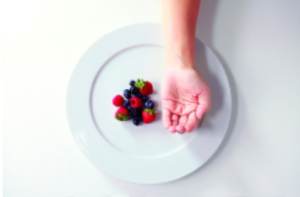
1 cupped-hand-sized carbohydrate portion per meal
Carbohydrates are the fuel for your engine. The product of their digestion, glucose, is an athlete’s primary source of energy. For meals, aim for whole grain, more energy-sustaining carbohydrates such as quinoa, whole grain bread, beans, lentils, pasta, oats, bran flakes and whole fruits. As you get 1-2 hours close to your training times, choose more refined, easily-digestible carbohydrates such as white bread, white rice, potatoes, corn flakes, rice crackers, dry fruits.
VEGETABLES

1 fist-sized vegetable portion per meal
Your mother wasn’t wrong when she claimed that vegetables were good for you. They are essential sources of vitamins that aid in your body’s biochemical processes. Think of vitamins as the nuts and bolts that keep a machine together. The machine, your body, is still able to perform work with some missing vitamins and minerals per se, but it works optimally and prevents breakdown with all the nuts and bolts in place. Aim to have two colorful vegetables at each meal: carrots + arugula in a salad, red pepper + eggplant in a ratatouille, spinach + cherry tomatoes in an omelette, etc.
PROTEIN
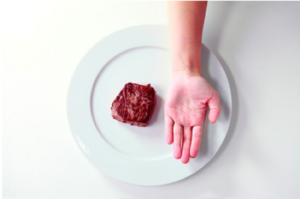
1 palm-sized protein portion per meal
Proteins are digested into amino acids, which are used in your body to synthesize muscle. They also help produce hormones, antibodies, enzymes and other required proteins in your body. Try to spread out your protein intake throughout the day for optimal energy and muscle recovery. Some good sources of proteins include eggs, poultry, pork, beef, milk, cheese, and yogurt. Great plant-based proteins include nuts, tofu, chia seeds, pumpkin seeds, beans, lentils, and chickpeas.
HEALTHY FATS
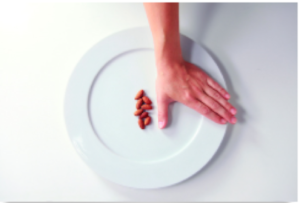
1 thumb-sized fat portion per meal
Fat gives us the feeling of satiety. Essential fatty acids present in fish, flax seeds, hemp seeds, and walnuts are necessary to reduce muscle and joint inflammation and for healthy brain function. Aim for plant-based sources such as nuts and seeds, avocados, olive oil, and fatty fish such as salmon and mackerel.
PUTTING IT ALL TOGETHER: THE ATHLETE’S PLATE
Energy intake should match energy expenditure to optimize performance. (Benardot, 2012). It’s a simplistic concept; the harder you work and the more you sweat, the more calories you’ll need to maintain energy balance. Your nutrient and energy needs are going to vary daily – between practise days, workout days, tournament days and rest days.
Below are three great visuals from the US Olympic Committee to give you a guideline for what a balanced plate may look like for you, for three different training days.
Use this easy training Athlete’s Plate on your rest days and easy-training days.

Use this moderate training Athlete’s Plate when you’re training regime involves moderate sprint or endurance sessions.
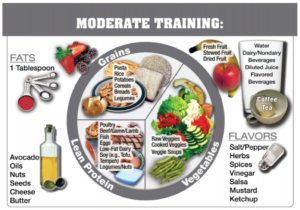
Use this hard training Athlete’s Plate to load up during your tournament days and hard-training days.
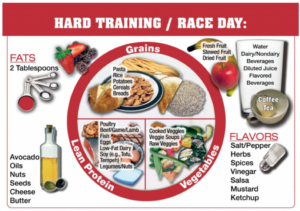
The next article in this series will feature the topic of Nutrient Timing.
If you have any questions or feedback, feel free to shoot us a message!

![International Women’s Day 2019 [Presented by VC Ultimate]](/c/wp-content/uploads/2019/03/unnamed-218x150.jpg)





